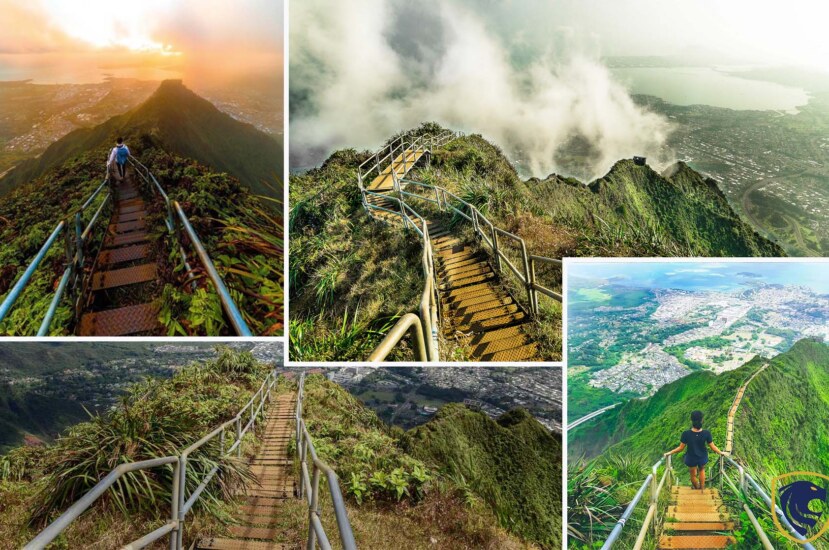Haiku Steps, also known as the Haiku Stairs or the Stairway to Heaven, is a breathtaking hiking trail located on the island of Oahu in the state of Hawaii. This awe-inspiring trail has a rich history and offers stunning views, making it a popular destination for adventure seekers and nature enthusiasts.
The Haiku Steps trail is nestled in the Ko’olau Mountain Range. It is near the town of Kaneohe, on the eastern side of Oahu. It consists of a series of nearly 4,000 steps that ascend the steep slopes of the mountains. That leads hikers to an elevation of approximately 2,800 feet. The trail offers panoramic vistas of the surrounding lush valleys and majestic peaks. Moreover, hikers can witness the sparkling blue waters of the Pacific Ocean.
The history of Haiku Steps dates back to the early 1940s when it was initially constructed by the U.S. Navy as a part of a top-secret radio transmission facility. During World War II, the Navy installed a series of antennas at the summit of the mountains to establish a communication link with its submarines operating in the Pacific. The steep staircase was built to provide access for the Navy personnel.
After the war, the facility was decommissioned, and the stairway fell into disrepair. However, its stunning location and breathtaking views attracted adventurous hikers who were willing to take on the challenging climb. Despite being officially closed to the public due to safety concerns, Haiku Steps gained popularity through word-of-mouth and social media, drawing hikers from around the world to test their mettle on its legendary steps.
The Physically Demanding Experience

The Physically Demanding Experience
The trail itself is an exhilarating and physically demanding experience. The stairs, which were originally made of wood. But later replaced with metal, ascend steeply through dense vegetation and narrow ridges. The lush greenery and occasional waterfalls along the way add to the trail’s natural beauty. That provides a sense of serenity and tranquility amidst the physical exertion.
Reaching the top of Haiku Steps offers an incredible reward. At the summit, hikers are greeted with a panoramic vista that stretches across the island. The sweeping views of the windward coast, the emerald valleys, and the endless expanse of the Pacific Ocean leave visitors in awe and provide a profound connection with the natural wonders of Hawaii.
It is important to note that due to safety concerns, the Haiku Steps trail has been officially closed and marked as trespassing. The steepness of the stairs, weather conditions, and the potential for accidents have led to the closure. However, the allure of this iconic hiking trail remains, and discussions continue regarding its future accessibility and preservation.
Haiku Steps, with its intriguing history and stunning natural surroundings, captures those who seek it out. The trail’s official closure has limited access to the general public. But the allure of its breathtaking views and the challenge of conquering its legendary steps continue to inspire hikers and explorers from around the world.
How Did Haiku Mountains Form?
The formation of the Haiku Steps mountain, also known as the Ko’olau Range, is the result of volcanic activity. Also, erosion over millions of years has molded the landscape. The Ko’olau Range is part of the larger Ko’olau Shield Volcano, which is one of the two major volcanoes that form the island of Oahu in Hawaii.

Stairway to Heaven; The Haiku Steps
The formation of the Ko’olau Range began around 2.6 million years ago when volcanic eruptions occurred, leading to the accumulation of layers of lava and volcanic ash. Over time, as the volcanic activity subsided, the lava cooled and solidified, forming the foundation of the mountain. Erosion, primarily driven by water and wind, then shaped the mountain over millions of years, carving deep valleys and steep ridges.
The Vegetation In The Area
The native vegetation in the area surrounding the Haiku Steps is incredibly diverse and unique. This area reflects the ecological richness of Hawaii. The lower elevations of the mountain are characterized by lush tropical rainforests. Those are known as mesic forests, which are dominated by large trees, ferns, and various epiphytes. Native tree species such as koa (Acacia koa), ohia lehua (Metrosideros polymorpha), and kukui (Aleurites moluccanus) thrive in this environment.
As the elevation increases, the vegetation transitions into what is known as montane wet forests. Here, the climate is cooler, and cloud cover is more prevalent. The montane forests are home to a variety of unique plant species, including the native Hawaiian lobeliads (Lobelia spp.), ‘oha wai (Cyanea spp.), and the vibrant ‘i’iwi (Vestiaria coccinea) bird-pollinated flowers.

The Vegetation In The Area
Above the montane forests, the vegetation becomes more sparse due to harsher climatic conditions. The ridges and peaks of the Ko’olau Range are often covered by hardy native grasses, shrubs, and groundcover plants, specially adapted to withstand strong winds and limited soil conditions. These areas are known as subalpine shrublands or dryland shrublands.
The native vegetation in the area surrounding the Haiku Steps is not only visually stunning but also ecologically important. It provides critical habitat for numerous endemic plant and animal species found nowhere else on Earth. The preservation and restoration of these native ecosystems are vital for the long-term conservation of Hawaii’s unique biodiversity.
Respect The Nature During Your Visit
It is important to note that when visiting the Haiku Steps or any natural area in Hawaii, it is essential to respect and protect the native vegetation. Invasive species, such as strawberry guava (Psidium cattleianum) and miconia (Miconia calvescens), pose significant threats to the native flora and fauna. Taking care to prevent the spread of invasive species and staying on designated trails helps preserve the delicate balance of these fragile ecosystems.

Stairway to Heaven; The Haiku Steps
Overall, the formation of the Haiku Steps mountain within the Ko’olau Range is a result of volcanic activity. Also, millions of years of erosion have molded the mountain. The native vegetation in the area showcases the remarkable biodiversity of Hawaii. There is a range of plant communities adapted to different elevations and climatic conditions. Preserving and appreciating the native vegetation is essential for the conservation of Hawaii’s natural heritage.
Present status Of The Haiku Steps
As of my knowledge cutoff in September 2021, the present status of the Haiku Steps, also known as the Stairway to Heaven, is that it remains officially closed to the public. The stairway was closed in 1987 due to safety concerns. And has since been marked as trespassing. However, its popularity among adventurous hikers and the allure of its breathtaking views continue to attract visitors, despite the closure and restricted access.

Present status Of The Haiku Steps
The closure of the Haiku Steps was primarily due to the deteriorating condition of the stairs. Also, there was a potential hazard associated with the steep and precarious climb. The stairway has suffered from years of exposure to the elements and lack of maintenance. The weather conditions in the area, including high winds and heavy rainfall, have further contributed to the deterioration of the infrastructure.
Despite being officially closed, estimates suggest that a significant number of visitors attempt to hike the Haiku Steps each year. The allure of conquering the legendary staircase and witnessing the panoramic views from the summit attracts adventure seekers from around the world. The popularity of the trail has been amplified through social media platforms. The stunning photos and videos shared by hikers have captivated the imagination of many.
Visitors Are Coming Unofficially
The exact number of visitors per year is challenging to determine accurately due to the unofficial nature of the access and the lack of official records. Additionally, the authorities do not encourage or endorse hiking the Haiku Steps due to safety concerns. However, it is believed that thousands of people attempt the hike annually, with the numbers varying depending on the visibility and publicity surrounding the trail.

Visitors Are Coming Unofficially
The high demand for hiking the Haiku Steps has presented challenges for local authorities and residents. Concerns have been raised about the impact on the environment. That includes the fragile native vegetation and the strain on emergency services in case of accidents or injuries. Local residents have expressed concerns about trespassing, noise, and traffic issues associated with unauthorized access to the trail.
The government have taken steps to explore alternative solutions
Efforts have been made by the local government and community groups to explore alternative solutions. Such as the potential for legalizing and managing access to the trail. Proposals have been put forward to develop a legal and safer route to the summit. Those include the creation of a new trail or the rehabilitation of the existing stairs with appropriate safety measures.

Stairway to Heaven; The Haiku Steps
However, navigating the legal and logistical challenges of reopening the Haiku Steps has proven to be complex. Also, no definitive solution has been implemented yet. Discussions and debates continue among various stakeholders. Government officials, community members, and hiking enthusiasts are working to find a balanced and sustainable approach that considers both the preservation of the natural environment and the safety of visitors.
It is essential for individuals interested in hiking the Haiku Steps to respect the concerns of the local community. Trespassing on the trail not only poses safety risks. But also undermines efforts to find a long-term solution for access to this iconic site. Respecting the closure ensures the preservation of the natural beauty of the area and allows for the exploration of alternative options that can provide safe and sustainable access to the Haiku Steps.




